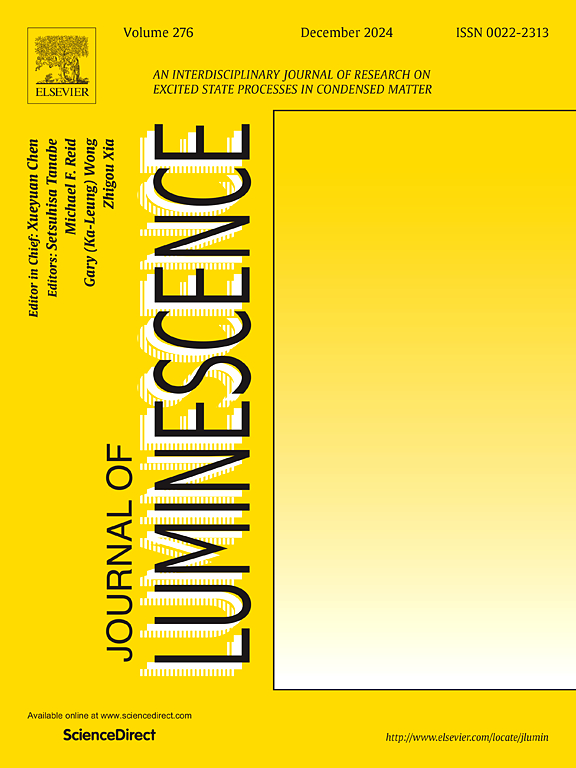碳气氛下退火对Zn2TiO4:Cr3+结构和持续发光性能的关键影响
IF 3.6
3区 物理与天体物理
Q2 OPTICS
引用次数: 0
摘要
持续发光(PersL)发射材料由于其在生物成像、辐射检测和防伪方面的应用而获得了极大的兴趣。本文研究了还原碳气氛下退火对掺杂Cr3+的Zn2TiO4逆尖晶石的结构、光学和perl性能的影响。x射线衍射(XRD)和紫外可见吸收光谱证实了Zn2TiO4相的保存。紫外线(254 nm和365 nm)和x射线预激发后的PersL研究表明,由于有效电荷捕获,空气退火样品呈现出延长的余辉,而碳退火样品则发生了显著的PersL猝灭,表明缺陷状态和重组途径发生了改变。x射线激发光学发光(XREOL)测量显示出不同的发射行为,碳退火诱导PersL猝灭,表明改变了陷阱深度和载流子相互作用。在340 nm激发下,空气退火样品获得了强热猝灭和碳-气氛退火样品的稳态光致发光抗热猝灭。我们预计锌和氧空位主导了整个发光机制。该研究为PersL荧光粉的缺陷工程提供了新的见解,为优化生物成像、辐射检测和下一代荧光粉应用的发光材料铺平了道路。本文章由计算机程序翻译,如有差异,请以英文原文为准。

Critical effects of annealing under carbon atmosphere on the structural and persistent luminescent properties of Zn2TiO4:Cr3+
Persistent luminescence (PersL) emitting materials have garnered significant interest due to their applications in bioimaging, radiation detection, and anticounterfeiting. This study investigates the impact of annealing in a reductive carbon atmosphere on the structural, optical and PersL properties of Cr3+-doped Zn2TiO4 inverse spinel. X-ray diffraction (XRD) coupled with UV–visible absorption spectra confirmed the preservation of the Zn2TiO4 phase. PersL studies after UV (254 nm and 365 nm) and X-rays pre-excitation demonstrated that air-annealed samples exhibit prolonged afterglow due to effective charge trapping, whereas, carbon annealed samples undergo significant PersL quenching, indicating altered defect states and recombination pathways. X-rays excited optical luminescence (XREOL) measurements reveal distinct emission behaviors, with carbon annealing inducing quenching of PersL, suggesting modified trap depth and charge carrier interactions. Strong thermal quenching in air-annealed samples and anti-thermal quenching of the steady state photoluminescence in carbon-atmosphere annealed samples upon excitation at 340 nm is obtained. We anticipate that the Zn and oxygen vacancies dominate the overall luminescence mechanism. This study provides new insights into defect engineering in PersL phosphors, paving the way for optimized luminescent materials for bioimaging, radiation detection, and next-generation phosphor applications.
求助全文
通过发布文献求助,成功后即可免费获取论文全文。
去求助
来源期刊

Journal of Luminescence
物理-光学
CiteScore
6.70
自引率
13.90%
发文量
850
审稿时长
3.8 months
期刊介绍:
The purpose of the Journal of Luminescence is to provide a means of communication between scientists in different disciplines who share a common interest in the electronic excited states of molecular, ionic and covalent systems, whether crystalline, amorphous, or liquid.
We invite original papers and reviews on such subjects as: exciton and polariton dynamics, dynamics of localized excited states, energy and charge transport in ordered and disordered systems, radiative and non-radiative recombination, relaxation processes, vibronic interactions in electronic excited states, photochemistry in condensed systems, excited state resonance, double resonance, spin dynamics, selective excitation spectroscopy, hole burning, coherent processes in excited states, (e.g. coherent optical transients, photon echoes, transient gratings), multiphoton processes, optical bistability, photochromism, and new techniques for the study of excited states. This list is not intended to be exhaustive. Papers in the traditional areas of optical spectroscopy (absorption, MCD, luminescence, Raman scattering) are welcome. Papers on applications (phosphors, scintillators, electro- and cathodo-luminescence, radiography, bioimaging, solar energy, energy conversion, etc.) are also welcome if they present results of scientific, rather than only technological interest. However, papers containing purely theoretical results, not related to phenomena in the excited states, as well as papers using luminescence spectroscopy to perform routine analytical chemistry or biochemistry procedures, are outside the scope of the journal. Some exceptions will be possible at the discretion of the editors.
 求助内容:
求助内容: 应助结果提醒方式:
应助结果提醒方式:


